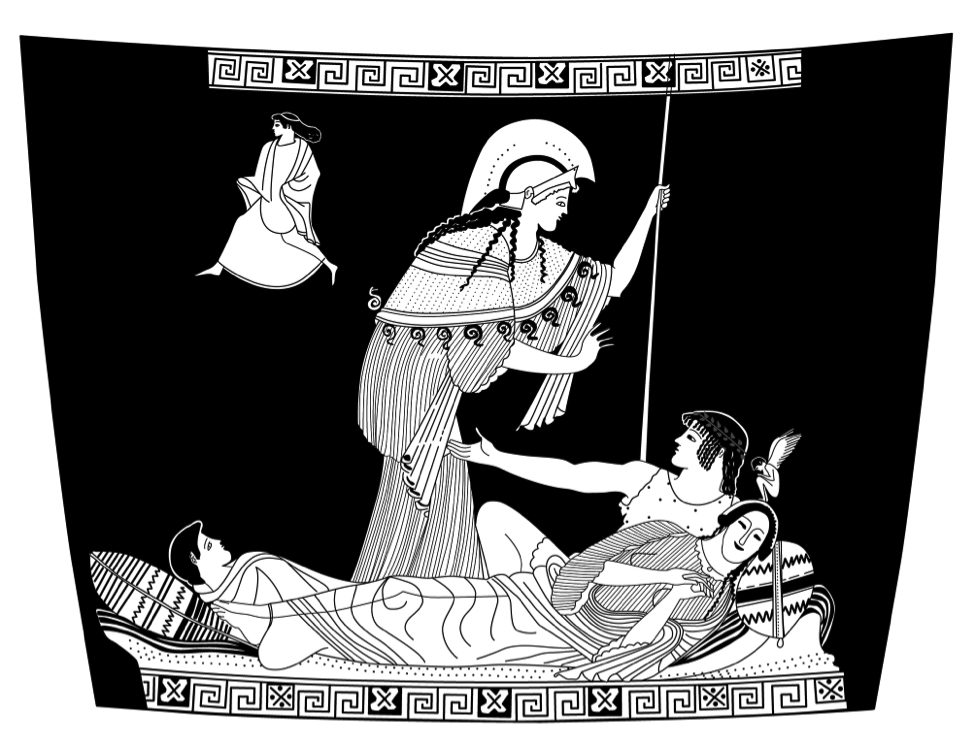457 venerat exstinctam ferroque extrema secutam?
458 funeris heu tibi causa fui? per sidera iuro,
459 per superos et si qua fides tellure sub ima est,
460 invitus, regina, tuo de litore cessi.
461 sed me iussa deum, quae nunc has ire per umbras,
462 per loca senta situ cogunt noctemque profundam,
463 imperiis egere suis; …
456 Unfortunate Dido! So it was true, then, the news that I got.
457 It came to me and said that you had perished, that you had followed through on your final moments with a sword.
458 So your death, ah, was caused by me? But I swear by the stars,
459 and by the powers above—and by anything here that I could swear by, under the earth in its deepest parts:
460 Unwillingly, queen, did I depart from your shore.
461 But I was driven by the orders of the gods, which force me even now to pass through the shades,
462 passing through places stained with decay, and through the deepest night.
463 Yes, I was driven by their projects of empire.
Unwillingly, O queen, did I depart from the top of your head.
60 ex Ariadneis aurea temporibus
61 fixa corona foret, sed nos quoque fulgeremus,
62 devotae flavi verticis exuviae,
63 uvidulam a fluctu cedentem ad templa deum me
64 sidus in antiquis diva novum posuit:
65 Virginis et saevi contingens namque Leonis
66 lumina, Callisto iuncta Lycaoniae,
67 vertor in occasum, tardum dux ante Booten,
68 qui vix sero alto mergitur Oceano. {158|159}
59 Then Venus, [9] intending not to let it happen, in the varied light of the sky, that only
60 the golden thing originating from the head of Ariadne,
61 her garland [corona], should have a fixed place there, but rather, that I too [= the lock of Berenice] might send forth a flashing light,
62 votive prize that I am, originating from a blond head of hair,
63 me, dripping wet from the rough seas of my weeping while heading straight for the celestial zones of the gods,
64 me did the goddess [Venus] situate, in the midst of old constellations, as a new one.
65 For, right next to the lights of Virgo and savage Leo,
66 next to their radiances, and joined to Callisto daughter of Lycaon,
67 I take my turn heading down into the western horizon, ahead of slow Boötes,
68 who plunges ever too late into the deep river Okeanos.

{160|161}
sed misera ante diem subitoque accensa furore
nondum illi flavum Proserpina vertice crinem
abstulerat, …
For, since she was about to die neither by fate nor by a deserved death,
but before her day, the poor wretch, inflamed as she was by her sudden frenzy [furor], {163|164}
it had not yet happened to her that the blond hair on the top of her head [vertex], at the hands of the goddess of death,
was to be taken away from her.
δῶρον, ὅτ’ εἰς Οὔλυμπον ἀνήγαγε δῖαν ἄκοιτιν
Μίνωος κούρην ἐρικυδέα, τήν ποτε Θησεὺς
κάλλιπεν οὐκ ἐθέλων <γε> περικλύστῳ ἐνὶ Δίῃ·
They [= the wine vessels] were made by Hephaistos for most radiant Dionysus
as a gift, at the time when he took to Olympus as his luminous bride
the daughter of Minos, that most glorious one, the one whom Theseus once upon a time
left behind—unwillingly—on that island surrounded by the sea, Dia.
Unwillingly, queen, did I depart from your shore.
